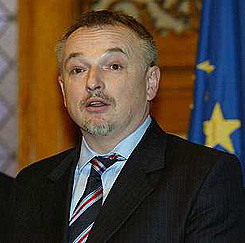
UNCONVENTIONAL GAS EXTRACTION IN HUNGARY
Publication: Eurasia Daily Monitor Volume: 5 Issue: 90
By:

Hungary’s MOL oil and gas company has entered into a partnership with ExxonMobil of the United States and Falcon Oil & Gas of British Columbia, Canada, to develop the gas deposits in Hungary’s Mako Trough. With this project, North American energy companies are directly entering the hydrocarbon production sector in Central Europe for the first time. The agreements just signed are a follow-up to the preliminary ones signed in 2007, when the companies ascertained the presence of sizeable deposits of unconventional gas in that area.
The Mako Trough is located in the Pannonian depression in southeastern Hungary, near the point where the borders of Hungary, Romania and Serbia intersect. The Mako Trough holds an estimated 1.2 trillion cubic meters of gas, including 340 billion cubic meters susceptible to commercial development. These recent estimates by the Scotia Group consultancies are in line with MOL’s preceding estimates. Drilling is scheduled to start before the end of 2008, with exploration wells eventually reaching a depth of 6,000 meters. Commercial production is anticipated to begin in 2011, with a potential to reach 10 billion cubic meters annually by 2012 and thereafter.
MOL and ExxonMobil each hold 40.4 percent of the acreage in the Mako contract area, with Falcon holding the remainder of 19.2 percent. The total investment is estimated at up to $24 billion for the project’s lifetime of up to 30 years. Within the overall project, ExxonMobil signed separate parallel agreements last month with MOL and with Falcon for joint exploration and development of particular portions of the project area. ExxonMobil shares those acreage portions half and half with MOL and 67 percent to 33 percent with Falcon.
The companies envisage supplying Hungary’s internal market as well as nearby countries with gas from the Mako deposits. At present, Hungary relies on Russian gas for some 80 percent of its gas requirements. The dependence level is similarly high in several countries in the region. Gas extracted in Hungary could reduce dependence on Russian-delivered gas in Central Europe. At a minimum it can slow down the growth of that dependence, which Gazprom for its part seeks to increase through its South Stream project.
The Mako deposits contain “tight gas,” which is one of several forms of “unconventional gas.” While technically complex, the extraction of unconventional gas is rapidly becoming attractive commercially due to rapidly rising prices for the product and uncertain access in the main producing countries beyond Europe and North America. Within these two continents, unconventional gas is now recognized as the main basis for potential growth in extraction. In Germany, for example, BASF/Wintershall and Gaz de France are jointly developing tight gas deposits in the Ostfriesland basin.
Tight gas such as that in the Mako Trough is trapped in low-permeability, low-porosity rock, limestone, or sandstone formations. It necessitates advanced techniques and expensive processes for fracturing those formations, opening up a passage for the gas to the borehole, and possibly for dehydration of the gas. ExxonMobil brings its unconventional gas production technology to Hungary. For its part, Falcon has a niche capability in Canada for extraction of unconventional gas.
Hungary’s Socialist government is joining forces with Gazprom’s South Stream project through a state company to be specially created. In contrast, the privately owned MOL has not joined South Stream. MOL is merely offering Gazprom the use of an underground gas storage site in Hungary with a capacity of 1 billion cubic meters. The Serbian government has joined South Stream and brings to the project the storage site at Banatski Dvor, with a capacity of 800,000 cubic meters, in Serbia’s Vojvodina province in immediate proximity to Hungary’s Mako.
Those plans are not in competition with the Mako project. Even if South Stream materializes, which is far from certain, the disparity of size means that natural gas from the Mako project will be in high demand in Hungary and nearby Central European countries. If anything, the possibility that South Stream might reach the region provides an added rationale for offsetting the growth in dependence on Gazprom by providing supplementary sources of gas, such as Mako, in the overall supply picture (Business Wire, April 11, 14; MTI, Bloomberg, May 7; RosBusinessConsulting, May 6; Heti Vilaggazdasag, May 8).




